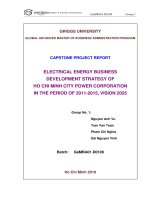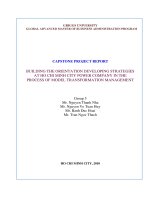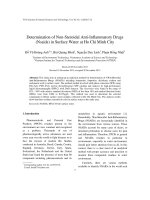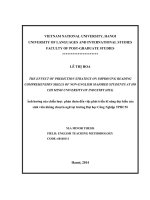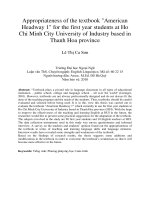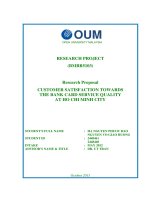Building the orientationdeveloping strategies at ho chi minh city power company in the process of model transformation management
Bạn đang xem bản rút gọn của tài liệu. Xem và tải ngay bản đầy đủ của tài liệu tại đây (1.02 MB, 92 trang )
GRIGGS UNIVERSITY
GLOBAL ADVANCED MASTER OF BUISINESS ADMINISTRATION PROGRAM
CAPSTONE PROJECT REPORT
BUILDING THE ORIENTATION DEVELOPING STRATEGIES
AT HO CHI MINH CITY POWER COMPANY IN THE
PROCESS OF MODEL TRANSFORMATION MANAGEMENT
Group 5
Mr. Nguyen Thanh Nha
Mr. Nguyen Vo Tuan Huy
Mr. Banh Duc Hoai
Mr. Tran Ngoc Thach
HO CHI MINH CITY, 2010
Page 2
TABLE OF CONTENT
COVER PAGE 1
TABLE OF CONTENT 2
LIST OF TABLE 4
LIST OF FIGURES 5
PREFACE 6
1. Over view: 6
2. Purpose and scope of research themes: 7
3. Objectives and scope of research: 8
4. Methodological: 9
Chapter 1 : BASIS OF METHODOLOGY 10
1.1. The concept of strategic management and management of change: 10
1.1.1. Concept of strategic: 10
1.1.2. Strategic Management: 11
1.2. Concept and classification business 13
1.2.1. Concept of business strategy: 13
1.2.2. Sort of business strategy 13
1.2.3. The strategic business unit 14
1.3. Business strategies planning Process 16
1.3.1. Identify tasks and mission of the enterprise 16
1.3.2. Define business objectives 16
1.3.3. Internal & External Environmental analysis 17
1.3.4. Analysis of internal environmental factors: 18
1.3.5. Analysis of External environmental factors 19
1.3.6. Setting business strategy: 21
1.3.7. Implemented business strategies solutions 21
1.3.8. Evaluate the effectiveness of the planned strategy 22
1.4. Some matrix and experience to select the strategies 22
1.4.1. External Factors: 22
1.4.2. Internal factors matrix: 23
1.4.3. SWOT matrix 24
1.4.4. Some experience in building business strategies 26
1.5. Human resource management: 27
1.5.1. Attracting and recruiting resource issues: 27
1.5.2. Using and maintenance of human resources issues: 28
1.5.3. The issue of training and developing human resources 28
Chapter 2 : ANALYSIS THE ACTUAL SITUATION OF HCMC POWER
COMPANY BEFORE TRANSFORMING THE OPERATION MODEL 30
2.1. Introduction 30
2.1.1. Name and address of company: 30
2.1.2. Process of building and development: 30
Page 3
2.1.3. Organizational structure: 31
2.2. Overview and analysis of the business three years ago of the company: 32
2.2.1. Business activities: 32
2.2.2. Results make business power: (Source: Report of the 2006-2009 Electricity
power Company of HCMC_Vietnam) 33
2.2.3. Total assets, total capital and the value of State capital at July 1, 2009
financial report: 39
2.2.4. Labor at the plan to set up HCMPC (July 1, 2009): 40
2.2.5. Some indicators of business results: 41
2.3. Internal and External Analysis 42
2.3.1. External : 42
2.3.2. Internal Factors Environment (IFE): 49
2.4. SWOT matrix 52
2.4.1. Internal factors: 52
2.4.2. External environment Factors: 54
2.5. Other issues in the business of the Company: 58
2.5.1. Effectiveness of the current model: 58
2.5.2. The existence of restrictions and the current model: 58
2.5.3. Conclusion and the need - proposed new model: 59
Chapter 3 : BUILDING THE ORIENTATION DEVELOPING STRATEGIES AT
HO CHI MINH CITY POWER COMPANY IN THE PROCESS OF
MANAGEMENT MODEL TRANSFORMATION 62
3.1. Verifiable fact 62
3.1.1. The productions business: 62
3.1.2. Investment in construction: 63
3.1.3. In the field of telecommunications: 63
3.1.4. Strategy brought decisive: 65
3.2. New performance model of the General Electricity Company City: 65
3.2.1. Proposed charter capital at the time of establishment: 66
3.2.2. Organizational structure and management model of the parent company -
General Power Company in Ho Chi Minh (HCMPC) 66
3.3. Analysis of the business of HCMPC after conversion: the environmental issues
related inside. 67
3.3.1. Advantages 67
3.3.2. Difficulty: 68
3.3.3. One of the main goals the establishment HCMPC: 70
3.4. Objectives and prospects in the new model: 73
3.4.1. Basic development goals: 73
3.4.2. Strategic business development objectives: 74
3.4.3. The solutions: 81
3.4.4. Recommendations: 88
Page 4
CONCLUSION 90
REFERENCES 92
LIST OF TABLE
Table 1-1: External Factors Matrix 23
Table 1-2: Internal factors Matrix 24
Table 1-3: SWOT Matrix 24
Table 2-1: Developing customer’s telecommunication, June 2009 37
Table 2-2: The business of the target company (Source: Report of the 2006-2008
Electricity of Vietnam) 41
Table 2-3: External Matrix elements of HCMC PC 48
Table 2-4:Matrix elements within the Electricity of Vietnam 51
Table 2-5: SWOT Matrix Power Company of HCMC 57
Table 3-1: The objectives of the business transformation activities 71
Table 3-2: Target investment HCMPC after conversion 72
Page 5
LIST OF FIGURES
Figure 1-1: process planning business strategies 16
Figure 1-2: Environmental activities of enterprises 17
Figure 1-3: The competitive model of Porter 20
Figure 2-1: Structure of HCMC PC 31
Figure 2-2: Market share of telephone in the country 45
Page 6
PREFACE
1. Over view:
In the years from 2006 to 2008 were recognized as the completely changing of
the global economic and it was ended by the seriously economic crisis in the year
2008. In Viet Nam, especially in Ho Chi Minh City, GDP had been changed
unexpectedly from the growth 12.6% in the year 2007 – highest in the period of
1997 – 2007- to 11% in the year 2008. Besides, the electricity industry has been
strongly affected by the specific characteristics such as unbalance between supply
and demand at some time because it is very difficult to forecast the unexpected
additional charge demand, some importance electricity net work improving projects
have been delayed, the transformers have got break-down result to the operation are
not stable. On the other hand, the inflation and the change of money policies in the
recent years of the Government (interest adjusting, adjust extend dollar exchange
rate) have affected the input cost for investment and production activities of almost
power agencies.
Studying the development of the world and region in this stage, it is
recognized as the stage of after industry and beginning of developing knowledge
economy. The economic structure of the world have changed rapidly therefore Viet
Nam has to adopt with it as well as taking full of owned potential in order to
develop the most accordance economic policy. Especially, the corporations, general
companies must give out the strategies in order to change the operation model,
which are accordance with the trend of the world. Especially, the Corporation must
be active construction plans for transformation activities in accordance with the law
of economic mobilization of domestic and international.
At present, the businesses are equally in business relation to each other in the
market. However, different type of business is treated unequally under the legal
documents system of the government. The state owned business run under the State
owned Enterprise law 2003. Whereas the other type run under The Enterprise law
2005.
Page 7
General policy of the State has confirmed transfer of state enterprises into
limited liability company member is a solution to continue the renovation of
management mechanism of state-owned enterprises, clearly distinguishing feature
representation rights state owned enterprise management functions, decentralization
more for businesses, and require higher liability of enterprises where the State needs
to hold 100% capital.
The Decision No 60/2005/QH11 on business law stipulates on November 29,
2005 that no later than four years from July 1, 2006 (on Business Law has effect),
the enterprises established accordance with the Law of SOEs 14/2003/QH11 on
October 12, 2003 must be converted into a Limited Company or Corporation.
Therefore, before July 1, 2010, Power Company of Ho Chi Minh City has converted
into Company Limited or Corporation. However, the Power Company in Ho Chi
Minh is the enterprise with 100% state capital, was stopped by the equalization of
text: 1332/TTg-DMDN on September 18, 2007 by the Prime Minister, should only
one form is converted into Corporation Limited in accordance with the time limits
prescribed by law business.
2. Purpose and scope of research themes:
To survive and grow in market economies with more competitive pressure, the
Electricity of Vietnam, in addition to the implementation of transformation
activities, need to build itself a business strategy effective. Derived from the actual
demands of the above authors have selected topics "BUILDING THE
ORIENTATION DEVELOPING STRATEGIES AT HO CHI MINH CITY
POWER COMPANY IN THE PROCESS OF MODEL TRANSFORMATION
MANAGEMENT”
Based on the theory of strategic management and related process analysis,
research on HCMC Power Company, the project directed to:
Evaluation whole situation of production and trading of HCMC Power
Company in recent years; identify the difficulties and advantages in the production
process, improving the quality of services to customers and increase labor
Page 8
productivity; the opportunities and challenges in the process of international
economic integration to build a new model work for the company.
The model works produced new business, continue to identify opportunities
and challenges are waiting for business to continue to offer the appropriate solutions
in the new period conversion, directed to stable operation business in the new
model.
3. Objectives and scope of research:
Objectives:
Objective research topic is the evaluation of a comprehensive real situation
of production and business activities of HCMC Power Company, to find out the
advantages, weaknesses, opportunities and threats from the company development
strategy to 2020.
Why choose the time of the year 2020 because this is a landmark time that
the State has set out is to move Vietnam into industrial countries, for the electricity
industry there is also the time of completing the grid system.
For authors made subject, this is the application of the theory of business
administration in a specific situations of life, through the medium tested and
advanced knowledge, both useful for the economic Current business is all the more
effective.
Scope:
Scope of research: Scope of the research topic is to develop theoretical basis
for building a business strategy for a basic business. For HCM City Power
Company's focus analyze a most basic elements that affect the construction
business from the proposed model works for HCMC Power Company in
accordance with the direction of international economic integration, removing
debug the barriers in operation at present, propose business strategies for HCMC
Power Company the new period. Content of the main topics include the following:
Chapter 1: Theoretical basis of strategic management and building strategic
business establishments and other related arguments: a part of these most basic
Page 9
concepts involved. Also a matrix to help select the business strategy and draw some
business from the study of theories on building business strategies.
Chapter 2: Situations business HCMC Power Company during the past:
This section introduces the history and development of the company, evaluation
summary of production and business situation of HCMC Power Company in recent
times, together with the analysis using tools such as M. Porter's five forces, the IFE
and EFE matrix, SWOT Since then find the opportunities, strengths and
weaknesses of the company as a basis for strategic planning of the company later in
the.
Chapter 3: in this chapter:
- Checking the analysis on the basis of the theory stated in Chapter 2 with the
actual business situation of the company in 2009.
- Proposed strategic transformation activities HCMC Power Company. Setting
business strategy of HCMC Power Company after the switch to operate the
model of parent company;
- Developing the strategic management and conversion predicts difficulties and
obstacles will be encountered,
- Recommendations related to transition to successful
- Conclusion
4. Methodological:
Topics focus on research, analysis of information directly from the Internal
of the HCMC power company in the most basic content.
Research and build a matrix selection strategy is done by methods experts,
that is consulted several experts deeply knowledgeable about the electricity
industry from which to establish criteria and evaluate the criteria. The advantage of
this method is simple to implement, but this method has drawbacks is the precision
usually not higher level than the survey because it is actually derived from the
subjective will to the experts. However this method is enough to build a good
business strategy.
Page 10
CHAPTER I:
BASIS OF METHODOLOGY
To be able to build a business model change for City Power Company in
accordance with the Enterprise Law, the general development trend of Vietnam's
economy on the path of international economic integration, team based on the
theoretical basis of the next theoretical research process, evaluating business:
- Theory of strategic management
- Theory classified business strategy
- Strategic planning process
- Some matrix and experience to choose strategies
1.1. The concept of strategic management and management of change:
1.1.1. Concept of strategic:
In the year 1962 Chandler strategy is defined as "determining the objectives
and purposes of the long-term business and the application of a series of actions as
well as the allocation of resources necessary to implement this objective”.
Chandler is one of the first to initiate strategic management theory. Until the
1980s when the strategic management disciplines have become popular, Quinn
defined more general: “Strategic planning is a pattern or integrating major goals,
policies and action sequences into a cohesive whole is closely”.
Then, Johnson and Scholes define the strategy of environmental conditions
have a lot of changes quickly: "Strategy is the direction and scope of the
organization in order to gain long term competitive advantage for organizations
through the format of its resources in the changing environment, easily meet market
demand and meet expectations of stakeholders.
We found that in all definitions of strategy have appeared phrases denote
different aspects should be included in it. Therefore, need to have diverse
definitions to better understand this area. In defining its strategy 5P, Mintzberg
general aspects of strategic management as follow:
Page 11
- Plan: the sequence of actions intended to consistently
- Pattern: being consistent behavior over time, may be intended or not intended
- Position: match between the organization and its environment
- Perspective: how to realize deeply about the world.
- Tricks (Ploy): specific ways to trick the opponent.
Not only includes many different aspects, to define strategies also vary by
level. The strategy defines the exact level depending on the nature of opinion.
Minimum level of three strategies should be identified: strategies for the company,
strategic business unit level and strategic functions. Company-level strategic
direction to the purpose and scope of the overall organization. Strategic business
unit level regarding how to compete successfully on the market specifically.
Strategic functions that assist strategic business level strategy and grant the
company an effective implementation by the components on the aspects of
resources, processes, people and skills needed. Currently, the trends of
globalization, companies are fast diversifying their activities beyond national
borders. Since then, global strategy as the choice to confront the problems with
international business.
1.1.2. Strategic Management:
1.1.2.1. Concept:
People often see senior management, but not all led the strategy as a product
of a rational planning process. In many cases, the strategic value can arise from
within the organization without a plan first.
Strategic management is a set of management decisions and actions determine
the long-term performance of a company. Management strategies include ongoing
action: Review the environment (both inside and outside), develop strategies,
implement strategies, evaluate and control strategies. Thus, research emphasis on
strategies to monitor and evaluate the external opportunities and threats in the
context of the internal strengths and weaknesses.
Page 12
Strategic management is derived business policies, management strategies
matching the topic with the long-term planning strategies. Strategic management is
derived business policies, management strategies matching the topic with the long-
term planning strategies. However, contrary to the strategic management, business
policy is oriented general management, primarily in the direction of interest in
integration activities between the functions of the organization. Meanwhile,
strategic management is not only interested in the integration of functions within the
same business policies but also emphasizes more on the environment and strategy.
Therefore, we use the term political strategy rather than policy business.
1.1.2.2. Task of strategic management:
Strategies Management including 5 tasks which is related closely is:
- Create a strategic vision of the future describe the image of the company,
clearly directed to where the company wants, how the company becomes. This
provides the main long-term orientation; specify the image that the company
wanted to be, transmitted to the company feel about action goals.
- Setting goals - metabolism perspective into the strategic implementation of
specific results that the company must achieve.
- Building strategies to achieve the desired goals.
- Implementation and operating strategies have been selected an effective and
efficient.
- Assessing the implementation and conduct adjustment prospect, long-term
direction, objectives, strategies or performance-based experience, the conditions
change, ideas and new opportunities.
- Benefits of strategic management:
The study showed that if there is a strategic management research.
Organization will achieve better performance compared to other organizations do
not perform this process. If achieved conformity between environments of the
organizational and strategies, the structures and its processes will create positive
effects on the performance of the organization. Benefits of strategic management
Page 13
have been tested in many different fields, with many companies with different
scales, which can short the three most basic points, that is:
- Made clearer strategic vision of the company
- Focus more precisely on what is the significance focused strategy
- Improve awareness of the rapid changes of environment
1.2. Concept and classification business
1.2.1. Concept of business strategy:
By Fred R. David, the strategy is the means to reach the long-term goals, also
according to historian Edward Mead Earle, "the strategy is the art of controlling and
using resources of a country or a coalition of countries aims to ensure and increase
the effectiveness of their vital interests" and much the same point. Thus, the strategy
is the direction and planning how to achieve the objectives.
Business strategy: According to Bruce Henderson, strategist at the same time
as the founder of Boston Consulting Group, "the business strategy is the careful
search for a plan of action to develop and combine the competitive advantages of
the organization. What difference between you and the competition is the basis for
your advantage? According to Professor Alfred Chandler of Harvard University
defines "Business strategy is the process of identifying the basic long-term goals of
the business, selecting the direction of action and allocates resources to implement
goals”
In the current competitive environment, we can say business strategy is to
identify business objectives, plan and allocate resources of the enterprise to create
competitive advantages to achieve business goals the best
1.2.2. Sort of business strategy
1.2.2.1. Classification level strategic strategies:
Strategy for the company: The overall strategy of the company to achieve
the goals of the company.
Page 14
Strategies for Business: It's the strategic part of the business units of the
Company, each unit will aim to achieve objectives for functional units and
indirectly help the company achieve objectives of the company
The strategic level function: It is the strategic functions of the company, such
strategic finance, strategic human resources, marketing strategy
1.2.2.2. Classifying by scope of strategy:
Strategic components: A two-level strategy such as strategic marketing,
financial strategies, pricing strategy, distribution strategy, promotion strategy
Strategy in common: also known as general strategy, referring to the most important
issues, most covering, long-term efficiency and deciding the survival of the
enterprise.
General strategy and strategic components closely associated together into a
complete business strategy.
1.2.2.3. Classifying of strategic approach:
Strategic focus: It focuses on the key one. It is of decisive significance for the
production and business of the company rather than spread resources.
Strategy based on the relative advantages: Ideology of strategic planning is
based on the analysis and comparison of products or services to its competitors, find
out the strengths to make the business strategic planning.
Strategic attack creativity: Business strategy based on the new exploitation in
order to gain the advantages to the competitors.
Free Strategy: The strategic does not aim the key elements but exploiting the
factors surrounding the critical factors.
1.2.3. The strategic business unit
1.2.3.1. Competitive strategies by M. Porter
Leading Strategy by low cost: A strategy to create competitive advantage
through low cost, low-cost is used for setting the price lower than the competitors in
order to attract almost customers who are sensitive of price to increase profits.
Page 15
Differently strategies: A strategy to create products, services and marketing
program is distinctly different compared with its competitors to attract customers.
Mixed strategy: combining low cost with differently strategies
1.2.3.2. Competitive strategies for business unit based on market share in the
market:
In business operation, each unit occupies different positions in the market, so
each unit has its own strategic that fits its position.
Strategy for the business unit leading the market: In every business has a
business unit which is considered to be leading the market, this unit has the largest
market share and leading competitors. To maintain this leading position, the unit
must have its own strategy:
+ Strategies to expand the total market demand: is the ability to make the most
consumed products.
+ Strategies to protect market share: Defense leadership position by always
reviewing strategies to protect its positions, often using the solution as always
rectification activities to keep costs low, perfect service, in order to retain
customers; diversification of products or innovative continuous
+ Strategies to expand market: share snatching, acquisition of smaller rival
units, attacking the weak competitor.
1.2.3.3. Competitive strategies for business units that challenges the market:
Often used for units that are second, third, fourth level in the market but it has
strong potential. It can attack the leading units and other units to increase market
share. To do this, it needs to identify goals, competition and select the appropriate
strategy to attack, perhaps strategies such attack in front, attacking the flank, or
attack line round
1.2.3.4. Strategies for the unit following the market:
That is the weak unit which is not enough strong to cope with the strong unit,
so it tries to follow the strong units. Strategies can be selected such as simulated
completely, that is totally imitating strong units; partly simulation, that is only
Page 16
partially mimic and improve the simulation, i.e., imitating and improvements to suit
with itself
1.3. Business strategies planning Process
According to the handbook, the Harvard business strategic planning process is
shown below:
Figure 1-1: process planning business strategies
1.3.1. Identify tasks and mission of the enterprise
Every business has duties or mission specific, all the activities of the
enterprise must be directed to their duties. Therefore, the production and business
strategy must also derive from the tasks of the business. Function as a basis for
business strategy and objectives of the strategy is aimed at completing the tasks of
the business.
Thus, the first work of the strategic planning process for the production of
business is to identify the task or mission of the business is what.
1.3.2. Define business objectives
The next step of the process of strategic planning of production and business
goals is to identify production and business enterprises. Goal is the result or
destination that a business will look forward to. It is the basis of the first and most
important strategy to build the planning of producing and business.
Page 17
Task or mission of the business is general. Goal is to concretize the task or
mission of the enterprise. For example, the Bank's mission is to mobilize capital and
loans. Therefore, specific objectives of the bank are how much the Bank will
mobilize and loan, for how long the duration, number and kind of customers.
Objectives are built on the basis of duty and mission of the business and
environmental factors inside and outside the enterprise. Objectives must be
consistent with the conditions both objective and subjective, that is, should be
considered construction and adjustment based on the environmental factors both
inside and outside the enterprise.
1.3.3. Internal & External Environmental analysis
Regardless of a business or an industry are also put in a certain environment,
encompasses both subjective factors (the internal environment) and other objective
factors (external environment). To analyze the environmental factors of internal and
external, we can use data available through surveys or studies from inside and
outside the enterprise.
Figure 1-2: Environmental activities of enterprises
Macro Environment
Micro Environment
Internal Environment
Page 18
1.3.4. Analysis of internal environmental factors:
The environmental factors are the main factors in the subjective; affect the
production activities of business enterprises, including factors that impact
positively and negatively. These factors have a positive impact is the strongest
point of the enterprise, as the skilled employees, professional modern production
lines; abundant financial resources; strong brand, famous, These factors have
negative impacts is the weakness of the business, such as production line obsolete,
old; financial resources tight,
Analyzing the environmental factors is to analyze the strengths and weaknesses
of the business.
To analyze the weaknesses we gather all the elements are disadvantages of the
business, analysis, comparison with competitors and assessing the adverse impact
to the business processes of each business factors, and indicate any factors that
negatively impact most businesses need to overcome concerns immediately, factors
which need to overcome.
To analyze strengths, we gather all the factors that dominated the enterprise,
analysis, comparison with competitors and evaluate the level of creating business
advantages for companies of every element that the only element that brings advantages
for the enterprise should make the most, factors that should make the next.
The main factors of the internal environment are:
- Manpower and Organization: Include factors such as quality of human
resources, organizational structure, maintenance policy and development of
human resources
- Financial resources, including such factors as: financial capacity, financial
management, accounting systems
- Production capacity, including factors such as line production technology,
production scale, product quality, production cost,
Management capacity, including such factors as: Capacity production
management, quality management, business management, human resource
Page 19
management, raw materials management
- Marketing and sales: including factors such as market research development,
system distributors, after sales service
1.3.5. Analysis of External environmental factors
External environment Factors is the objective factors, which affect the
production activities of enterprises, including positively and negatively factors.
These positive factors are the opportunity for business, as market demand
increases, support policies of the State, the moderator of the macro-economic state.
These negative factors are the threat to enterprises, such as the drop in market
demand; new competitors, rising of raw materials price
Analyzing the external environmental factors is to analyze the opportunities
and risks of the business.
To analyze the threat, we set all the elements from the environment outside the
enterprise. Analyzing and assessing the adverse impact to the business processes of
each business factors, and points out factors that have adverse impact for
businesses that need to avoid, what factors need to continuous interest
External Environmental factors can be divided into two kinds of macro-
environment and micro-environment.
To analyze the opportunity, we gather all the elements from the external
environment that can bring business opportunities to experiment. Analyze and
evaluate opportunities brought by these factors, and indicate what is the best
opportunity to be captured immediately, the opportunity should make next
The macro-environmental factors: macro-economic environment affect the
production and business of the enterprise: including factors such as economy,
politics, science and technology
The micro-environmental factors: Mainly competitive pressure in the economy
market. Enterprises often face the competitive pressure. A very effective tool to
analyze the competitive pressure is the model of 5 competitions of Porter.
According to the model diagram in Porter's competitive, enterprises must
Page 20
always bear in competitive pressure, including: competitive pressure from rivals in
the industry; competitive pressure from new competitors; pressure from customers;
pressure from suppliers and pressure from the product or service instead (Map 1.3.
Diagram of the competitive model of Porter)
Figure 1-3: The competitive model of Porter
Competitive pressure from existing rivals: In the business always exists several
business enterprises which have the same product? Therefore, to survive and
develop, these enterprises are always looking for ways to create advantages for
themselves to occupy the position among competitors, so a business must always
be competitive pressure from existing rivals.
Pressure from customers: Customers always ask companies to best meet their
needs. They require both product and price, so they are bargaining with enterprises
so that getting the best product with the lowest cost. Thus, business always is
pressure from the ability of customers to negotiate.
Pressure from suppliers: That is the input pressure. To conduct business,
Page 21
companies always need to raw materials and services from other providers.
Therefore, always be under pressure to negotiate from the suppliers.
Pressure from new competitors: They are potential competitors will appear and
create a pressure for the business side.
Pressure from the replaceable products and services: The products and services
will change the demand on the market, so will affect business processes of
enterprises.
1.3.6. Setting business strategy:
Pursuant to the objectives of the enterprise, the situation of internal and
external of the enterprise to establish business strategy includes the following basic
contents:
- Identify and select opportunities that can help companies achieve business
objectives set forth.
- Select target market of the enterprise. It helps businesses take full the best
opportunism.
- Choose products and services to supply the market goals.
- Building strategic marketing mix for market and product selected
o Product strategy: Identify types, number of product supply, quality, price,
size, design and other issues related to the product so that meet the
requirements of target market and can achieve the goals of the enterprise.
o Pricing strategy: Develop prices mechanisms with payment to meet customer
requirements.
o Distribution strategy: Organizing the distribution channels to bring products
to goal market quickly.
o Promotion strategy: This strategy supports building brands, improving image
business to attract more customers
1.3.7. Implemented business strategies solutions
That is the solution of human and financial resources, organizational business
management, production management in order to achieve the business strategy
Page 22
has been established. Or in other words it is the sort and arranges the resources of
the Company to successfully implement strategic business options, such as:
- Order business organizational structure appropriately
- Allocation, maintenance and development of human resources
- Allocate financial resources
- Build a model of management effectiveness
1.3.8. Evaluate the effectiveness of the planned strategy
An effective business strategy is consistent with the socio-economic situation, in
accordance with the state and enterprises can take advantage of good
opportunities to achieve business goals. So evaluate the effectiveness of
marketing strategy is very important. Evaluate the effectiveness of strategic
business primarily in the following steps:
- Reviewing and checking the suitability of business strategies before
implementing officially. Because, as mentioned earlier, business strategy is
decisive to the success or failure of the business, so it must be careful
verification.
- Evaluate the performance of the business phased implementation strategy
business to find out the deficiencies, the shortcomings of the strategy, from which
there is a modified and supplemented in time.
1.4. Some matrix and experience to select the strategies
1.4.1. External Factors:
1.4.1.1. Concept:
External factors Matrix is to evaluate the external factors that affect the
operation of the company, including the opportunities and threaten the company
1.4.1.2. How to build matrix:
Up listing all the external environmental factors that affect the operation of the
company, assessing the impact or the importance of each factor by the weighted
score, total points weighted of all elements in one or 100%.
Assessing the company's response to these factors by classifying the elements
Page 23
from 1 to 4, in which 4 means the companies have responded the best and 1 being
the lowest.
Followed by graded the importance of each factor by the weight of the points
classification, respectively, and then add up the points again to the importance of
finding critical points of the company. Significant higher total score is 4 and the
lowest is 1, and average is 2.5 points.
In the case of four points is that the company is to capture the best
opportunities and best threat control from outside. If the total score is 1, a company
that does not grasp the opportunity and cannot control the threat from the outside.
Table 1-1: External Factors Matrix
External factors
Essential
Level
Sort
Importance score
List the external
environmental
factors:
Total:
1,00
1.4.2. Internal factors matrix:
1.4.2.1. Concept
Internal factors Matrix is to evaluate the factors that affect the operations of the
company, including the strengths and weaknesses of the company.
1.4.2.2. How to build the matrix:
Up listing all the environmental factors that affect the operations of the
company, assessing the impact or the importance of each factor score by the
weight, total weight of points all elements equal to 1 or 100%.
Assessing the company's response to these factors by classifying the elements
Page 24
from 1 to 4, in which the four means the companies have responded the best and 1
being the lowest.
Followed by graded the importance of each factor by the weight of the points
classification, respectively, and then add up the points again to the importance of
finding critical points of the company. Significant higher total score is 4 and the
lowest is 1, and average is 2.5 points.
In the case of four points is that the company has much strength and can
overcome weaknesses. If the total score is one that the company has no strengths
and cannot overcome their weaknesses.
Table 1-2: Internal factors Matrix
Internal factors
Essential
Level
Sort
Importance score
List the internal
environmental
factors:
Total:
1,00
1.4.3. SWOT matrix
SWOT matrix is a tool that brings together the components of the internal and
external factors of the enterprise and associated factors into business strategy as
follows:
Table 1-3: SWOT Matrix
Page 25
1.4.3.1. Internal Factors
Those are internal factor of the enterprise, including positive factors (strengths)
and negative factors (weaknesses), as financial resources, human resources,
geographical location or technology
Strengths (Strong): These are the factors that create the strong advantages for
enterprises in production and business, such as Human resources with high quality,
strong capital, advanced technology, well known brand names To promote the
strength, enterprises need to list the strengths and then evaluate where is the
strength or core competence of enterprise.
Core capability is the foundation for the adjustment or new strategic plan, which is
a term professional expertise or skills in the company's main areas of operation,
the enterprise capacity has the advantage over competitors, which customers
appreciate. By David Collis and Cynthia Montgomery, core competence is
assessed in the following factors:
Opponents difficult to copy or imitate
Advantage lasting
Suitable for business
Sustainability
External factors
Internal factors
O (OPPORTUNITY)
Opportunities for businesses
T (THREATEN)
The risk to business
S (STRONG)
The strengths of the
business
S - O : Promoting
strengths to take advantage of
opportunities
S – T : Promoting
strengths to evade risk
W (WEAKNESS)
Weaknesses of the business
W - O : Overcome
weaknesses to take advantage
of opportunities
W - T : Engraving for
weaknesses to evade the
risk


